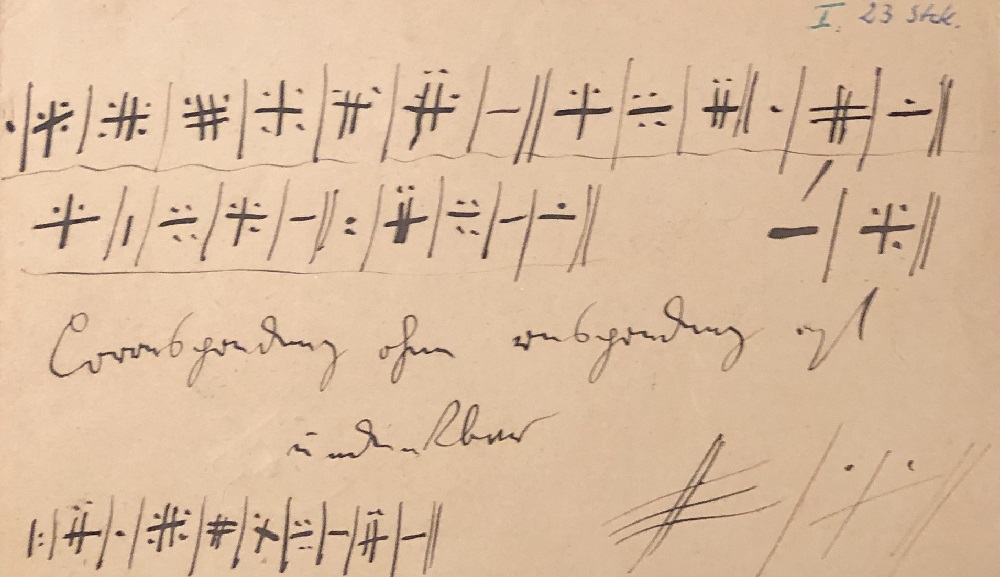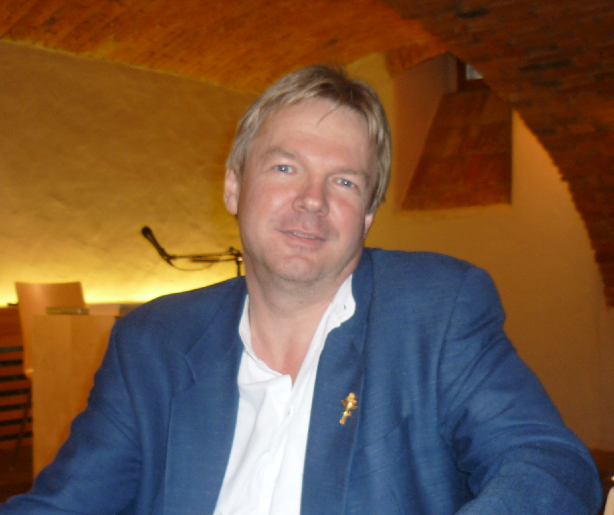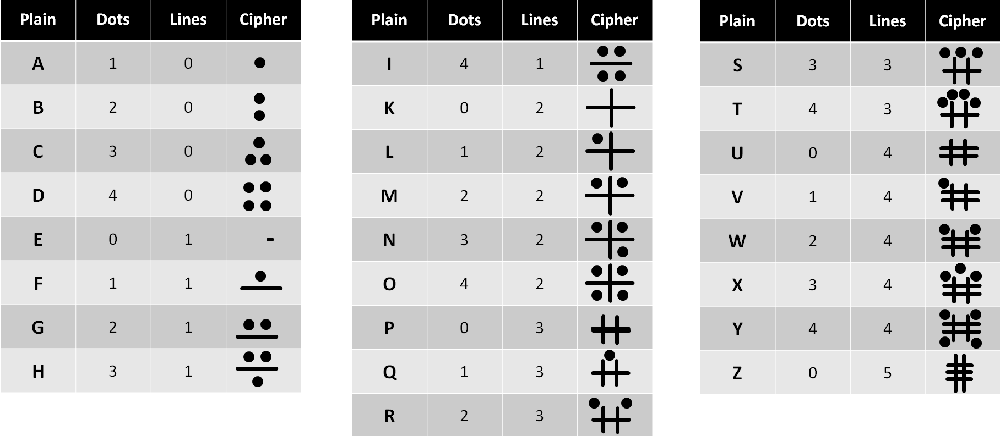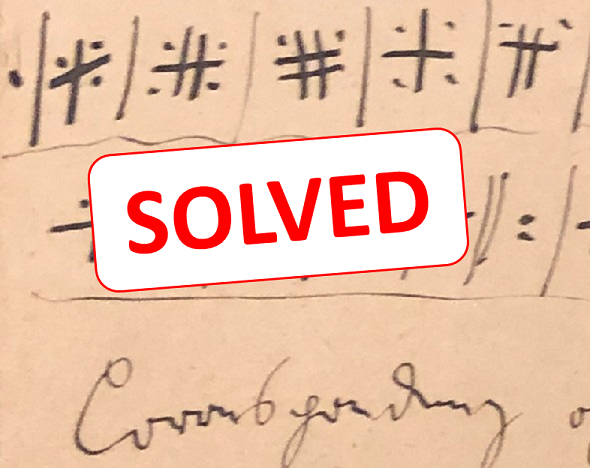Earlier this week, I blogged about two encpostcards sent to a Bavarian princess. My blog readers solved all the mysteries about these documents.
The two postcards I introduced last Tuesday were provided to me by Tobias Schrödel. Here are the messages written on these cards:

Source: Schrödel (used with permission)

Source: Schrödel (used with permission)
Before we examine the encrypted parts, we need to look at the two cleartext lines. They are hard to read. Peter Herden, Kyrmse, Thomas Bosbach, and Kerberos tried to make sense of them. The correct transcription probably is:
Correspondenz ohne Respondenz ist undenkbar.
This is German and translates to: “Correspondence without response is unconceivable.” I assume, this is an aristocratic way to say: “If I write you, I expect you to write back.”
Solution of the cryptograms
The most interesting part of the cards are, of course, the two encrypted messages. Blog reader Gerold „Gerry“ Haynaly from Graz, Austria, solved them within a day – another impressing codebreaking success achieved by my readers.

Source: Haynaly (used with permission)
Gerry is a high school teacher from Austria. His subjects are programming, network technology and IT security, where he shows his students, how vulnerable network devices and especially IoT gadgets are, and how important it is to protect them. In his spare time, he writes science fiction novels and thrillers – or tries to solve hacking and crypto challenges.
Thankfully, Gerry provided me a detailed and brilliantly written report on how he deciphered these cryptograms. Here it is:
Wow, when do you get to solve an encrypted postcard sent to a princess? What a challenge, as it was addressed to „Fürstin Wrede-Lobkowitz“!
At first I thought that the solution was pretty easy and straightforward. From the number of different symbols, it looked like MASC-encrypted text. The symbols consisted of up to four dots and up to five lines, so I assumed (afterwards proven correct) that a dot stood for 1 and a horizontal line for 5, resulting in 1 dot standing for an A and a horizontal line for an E. I like to solve those puzzles by hand without the help of online tools or CrypTool 2, so I took a sheet of paper.
But there the problems started. There was also a vertical line symbol! I tried with 5 for a horizontal and 10 for a vertical line, but there was also a hashtag-like symbol that would sum up to 30, contradicting the MASC-hypothesis. So I assumed that all lines meant 5. But that made things even worse. I did not recognize that I and J had the same value in the sender‘s alphabet, so the first word started with „AMSV…“ – end of transcription by hand…
I opened my laptop and fired up the usual suspects like Quipqiup (sorry, only English dictionary!),
Rumkin (Old and New German, but nothing useful; the old German dictionary found no solution at all) and the Guballa hill climber (which led to absolute gibberish).
So back to the drawing board! Did I make some error entering the ASCII representations of the code? No, but there were some weird symbols, for example an H with two dots, either on top or to the sides. What if they were to represent the same code? I decided to use the last word of the postcard, which was long enough that it would not be too ambigous, and it contained no different „spellings“ of the same code. I fed „ABCDEFGHBH“ into the three websites. Guballa found „LANDERSTAT“?, but Rumkin found 86 words, most of them ending in „…TET“ which I thought
would not be the right words. But there was one word that seemed right: „GRATULIERE“.
When I entered the word on my paper and filled in the known letters in the upper two lines, three of the words looked like .IR AU. .RIE.
Taking my first idea (two dots for B and a line and a dot for F) I got .IR AUF BRIEF. Now I could build a table with the symbols and the ASCII characters, which revealed the final solution.

The weird symbols meant the same as their non-weird counterparts, a dot wherever positioned stood for 1 and every line for 5. Adding up the numbers gives A=1, B=2, … I=J=9, and finally Z=25. This led to the identity of the sender of the postcard as „ZM“ and not Maria Anna‘s
husband Carl Philipp von Wrede. So this is the final solution:
ANTWORTE MIR AUF
MEINE BRIEF E?N
GRATULIERE ZM
Translation: Please reply on my letter. Congratulations on.
Christof Rieber from Vienna, Austria, deciphered the cards, too. He came to the same result.
The initials
Thomas Bosbach provided some interesting facts about the sender and the recipient of the cards. Especially, he found out what the initials probably mean:
- Maria Anna’s brother Ferdinand von Lobkowitz and his family were living in the castle of Dolni Berskovice. Most likely the card came from there. “P.F.” might stand for “Prinz Ferdinand”, “I” for his wife Ida, “Z” and “PLS” for the other brother Zdenek and his wife Paula von Lobkowitz-Schönborn. Judging from the encrypted text, her siblings missed a response to a preceeding letter.
- According to the key figured out by Gerry (great job!), the characters under PF stand for HO. I presume the circle with the stroke stands for ch, so that it reads “Hoch!”
- The second card has a postmark from Brüx (czech. Most). Near Brüx the Lobkowitz family had another castle, Eisenberg. Judging from the adresses, the writer of both cards was the same, presumably Prinz Ferdinand (P.F.). Here is a Kurrent handwriting example from him. What do you think, does his handwriting resemble to the Kurrent part of the second card?
- Probably, the encrypted initials ZM stand for Maria Anna’s second brother, Maria Zdenko (Czech. Zdenek) v. L., who also lived in the family’s castle in Dolni Berkovice. Maybe the background of the congratulations was that Maria Anna was expecting her first child (born on Sept. 14, 1890).
As it seems, all of the many mysteries about these two postcards are solved now. Thank you very much to Gerry and all other blog readers woh contributed to this great success! Once again, I am proud to have so many skilled supporters.
Follow @KlausSchmeh
Further reading: Who can decipher this encrypted postcard from Wisconsin?
Linkedin: https://www.linkedin.com/groups/13501820
Facebook: https://www.facebook.com/groups/763282653806483/



Letzte Kommentare